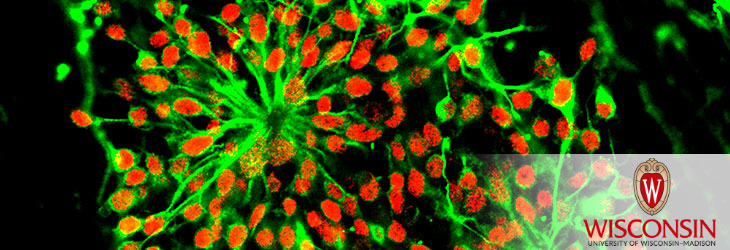Pluripotent Stem Cells

STEM CELL FATE ENGINEERING METHODS
WARF: P210249US02
Inventors: Sean Palecek, Gyuhyung Jin
The Invention
UW-Madison researchers have developed a simple and versatile method to spatially pattern hPSC differentiations via localized adsorption of morphogens on substrates. Morphogens including BMP4, noggin, activin A, and Wnt3a were patterned to induce localized mesendoderm, endoderm, cardiomyocyte (CM), and epicardial cell (EpiC) differentiation from hPSCs and hPSC-derived progenitors. Patterned cardiomyocyte and epicardial cell co-differentiation allowed investigation of interactions between the cells in a spatially controlled manner and demonstrated improved alignment of cardiomyocytes, an important metric of maturity and coordinated function, in proximity to differentiating epicardial cells. This simple approach provides a platform for controlled, systematic study of spatiotemporal pattern formation during early development. Moreover, this technology provides a facile approach to generate patterned hPSC-derived tissue structures for modeling disease and drug interactions.
Untreated polystyrene culture plates have a relatively hydrophobic surface, so standard tissue-culture plates are treated to create a hydrophilic surface to promote adhesion. A key element in the present invention is the inventors’ use of untreated culture plates, on the surface of which they deposit protein solutions that adsorb to the surface over the course of a short incubation; they then withdraw excess solution, and then layer appropriate growth matrices (e.g., Matrigel) and cells on top. They found they could adsorb the proteins/morphogens of interest in patterns (via a variety of application methods) and observe responses by cultured cells in accordance with those patterns.
Untreated polystyrene culture plates have a relatively hydrophobic surface, so standard tissue-culture plates are treated to create a hydrophilic surface to promote adhesion. A key element in the present invention is the inventors’ use of untreated culture plates, on the surface of which they deposit protein solutions that adsorb to the surface over the course of a short incubation; they then withdraw excess solution, and then layer appropriate growth matrices (e.g., Matrigel) and cells on top. They found they could adsorb the proteins/morphogens of interest in patterns (via a variety of application methods) and observe responses by cultured cells in accordance with those patterns.
Additional Information
For More Information About the Inventors
Tech Fields
For current licensing status, please contact Andy DeTienne at [javascript protected email address] or 608-960-9857